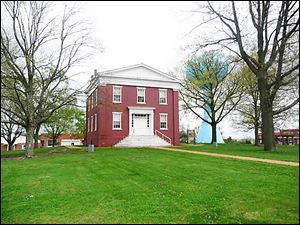
Class raises $9,500 to help Ill. courthouse where Lincoln once practiced law
4/5/2013
The Mount Pulaski Courthouse, built in 1848, was Logan County’s seat of government until 1855. Attorney Abraham Lincoln regularly argued cases in the second-floor courtroom, helping to establish his reputation.
MOUNT PULASKI, Ill. — Illinois third-graders’ modest initiative to help with upkeep at a historic local courthouse where President Abraham Lincoln once practiced law has turned into an $9,500 boon to efforts to maintain the building during lean budget times in the state.
Mary Ann Radtke, a third-grade teacher at Mount Pulaski Grade School, said the fund-raiser is testament to the children’s adroitness at using social media. Their Facebook posts and YouTube videos of television news reports about the effort have attracted donations from throughout central Illinois and as far away as Alaska and Germany, she said.
“We had a story in our reading book about a girl who gave a dollar to help save a zoo, and the kids asked, ‘Can we do that?’ ” Mrs. Radtke said.
The teacher said it was possible if an appropriate cause could be identified. Soon after, she received a fund-raising letter from the Mount Pulaski Courthouse Foundation, which had organized in 2011 to coordinate local efforts to help with the building’s upkeep.
“We’re studying Abraham Lincoln, we’re studying his life,” Mrs. Radtke said.
So it made sense to propose dedicating the children’s philanthropic energy to supporting the local historic site, which from 1849 to 1855 was one of several courthouses in the area where Mr. Lincoln argued cases before Illinois’ 8th Judicial Circuit.
The students set up collection cans for “Courthouse Cash” throughout the community, which was the seat of Logan County for just seven years before that status was transferred to the city of Lincoln, built along a railroad line in 1852 that bypassed Mount Pulaski.
The class promoted the fund-raiser by suggesting that donating $1 would equate to giving up one can of soda, Mrs. Radtke said. Based on Mount Pulaski’s population of about 1,900, she said, the children thought they might raise $2,000, but their teacher thought $500 was a more reasonable goal.
Tom Martin, the courthouse foundation’s chairman, said the school’s fund-raiser has been so successful that cash on hand now exceeds the cost of repair projects that are ready to go, so a new list is being developed.
“I told the kids that giving back to your community brings you rewards, makes you feel good about yourself,” Mr. Martin said. “Their families and the whole community should be really proud of them.”
Once Mount Pulaski lost its county seat, the local courthouse became city offices, a schoolhouse, a community center, and a post office. In 1935, the state of Illinois bought the two-story Greek Revival building and began efforts to restore it to its 1850s appearance as a historic site. In 1978, it was added to the National Register of Historic Places.
While the building is in no danger of becoming derelict, its maintenance has suffered in recent years because of tight state budgets, Mr. Martin and Chris Wills, a spokesman for the Illinois Historic Preservation Agency, agreed.
“The site is in good shape, but there’s always maintenance work that needs to be done. And all of our sites’ maintenance is taking a little longer to get to,” Mr. Wills said, noting that the state also owns the other surviving 8th Circuit courthouse where Mr. Lincoln routinely worked, in Metamora, Ill., near Peoria.
Mr. Martin said the courthouse foundation organized during Mount Pulaski’s 175th anniversary celebrations, with its leaders seeking some sort of “legacy project” they could undertake.
Although it remains open to the public five days a week, “the building is in disrepair,” Mr. Martin said. “Routine maintenance has fallen by the wayside for the last 10 or 15 years.”
The foundation set a goal to raise $20,000 in each of the next five years, the foundation leader said. It met that goal last year and, with the children’s help, is almost halfway there already.
Mrs. Radtke said the volume of donations to Courthouse Cash has been exciting for both her and her class. Besides Germany and Alaska, checks have come in from California, Oregon, Florida, Iowa, Kansas, and Missouri.
“Courthouse Cash” donation canisters around town will be gathered up today, she said, but “we’ll accept funds for as long as they come in.”